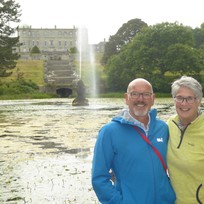( Overview
/ Two Scilly Bullocks on a Boat
After an enormous breakfast at the cafe on the quay, and ordering a new bilge pump and Tesco shop online, we felt we needed some exercise (although walking up the steep slope to the showers and chandlery is a strenuous enough workout).
Crossing the fields into Bodinnick, and then joined the Hall Walk which takes in woodland and the tranquil Pont Creek. A ferry crossing was first recorded in 1344, but a river crossing has probably existed much longer as it is part of the main trade route through Cornwall to London.
Many of the houses in Fowey have steps down to the water, and we liked this ingenious way of storing ribs.
Sir Arthur Quiller-Couch (1863-1944) or “Q” lived in Fowey from 1891 and is buried in the parish church. A prolific writer of novels, he also edited the “The Oxford Book of English Verse 1250-1900”. A keen waterman, he is said to be the model for Ratty in Kenneth Grahame’s “The Wind in the Willows”.
Pont Pill is a tidal river which joins the River Fowey at Penleath Point, just below the “Q” memorial.
Despite its tidal location Pont Pill quay became important for trading roadstone, bricks, coal, manure and flour and exporting grain and logs. In 1814 it was a thriving community with granary, limekilns, malthouses, corn and saw mills, a beer house and a blacksmith shop.
The bridge at Pont, in old Cornish Pont Pyll, meaning bridge of the creek, the end of navigable water.
Part way to Polruan is the site of an isolation hospital in 1889 for sailors arriving with infectious diseases. Post World War II, the Pill was the final resting place for many wooden sailing ships, and it was here du Maurier discovered the schooner, Jane Slade, which inspired her first novel.
In 1602 Carew described Hall Walk as a place of diversified pleasings. Not so much for a poor fisherman who was shot and killed here in 1644. King Charles had been standing there just a short while before and narrowly escaped death.
Pill boxes remain from World War II in the ancient Truan woods. Due to the number of American and British troops stationed here, and the license to export ammunition, Fowey became a ‘secret port’. Fowey was targeted by enemy bombers many times, when bombs, incendiary devices and mines were dropped.
Fishing vessels were being repaired and serviced on the quay, including a sister ship of the very pristine vessel we saw the other day.
We took the ferry from Polruan to the Whitehouse Slip. Before a motor boat was introduced in 1912, the ferry was a rowing boat, and the passengers had to land onto rocks.
The earliest harbour official was the Havener who collected dues on behalf of the Duke of Cornwall. On both imports and exports, this was often paid as a percentage of the cargo, for example wine! When trade increased and improvements required, the Harbour Commissioners were established in 1869.
The Princess of Discovery; her construction and delivery were delayed because of the Covid-19 pandemic, but she is the sixth and final Royal-class cruise ship in the Princess fleet. The weather had turned windy and mizzly,and we wondered about the trip in the tender - it didn’t look comfortable!
Another climb (we’ve done a lot of that today) to St Catherine’s Castle. A gun tower built by Thomas Treffry for Henry VIII, as part of a national defence programme. The tower’s heavy guns protected the harbour and musket loopholes were added later.
Looking down on Readymoney Cove. Unfortunately with the mizzly, cool weather and rubbish amongst the seaweed on the beach, it didn’t look an inviting place for a swim.































 Sign in with Apple
Sign in with Apple  Log in with Facebook
Log in with Facebook